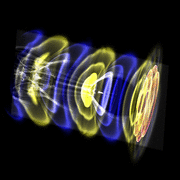
CCSE Home |
Overview |
AMReX |
People |
Publications |
Electrodynamics
CCSE Members of the Electrodynamics Development Team
|
Accelerator Modeling with WarpX

|
WarpX is an accelerator modeling code for the exascale being developed as part of DOE's Exascale Computing Program.
CCSE researchers contribute to the core AMReX-based infrastructure for WarpX, and the implementation of
sophisticated mesh refinement algorithms. Ongoing work includes extension of WarpX to work efficiently
on hybrid CPU/GPU platforms.
The official ECP project page is here. The WarpX project is also a member of the NERSC NESAP-for-ECP program. The project is led by Jean-Luc Vay of LBL's Applied Physics and Accelerator Technologies Division. More information about the WarpX software can be found at https://ecp-warpx.github.io/ |
Astrophysical Plasma
In a new project which builds on the wave propagation methodology used in accelerator modeling, we are extending the capabilities of WarpX to model pulsar magnetosphere and relativistic magnetic reconnection relevant to various astrophysical phenomena.
Even though relativistic magnetic reconnection has been widely studied in the literature, the key mechanisms that govern the transfer of energy from the magnetic field to kinetic energy of accelerated charged plasma species are not well understood. Modeling the Harris-sheet magnetic reconnection problem using the ab-initio particle-in-cell approach will allow for the study of microscale kinetic behavior and its effect on the macroscale acceleration, reconnection rate, and plasmoid instabilities.
Pulsar magnetospheres and magnetic reconnection have never been studied with an AMR code; using this capability for modeling Maxwell's equations requires special care at the coarse-fine grid interface. The use of AMR will greatly reduce the computational cost since the length-scale of the magnetic reconnection system increases by nearly two orders of magnitude away from the current-sheet. The disparity in length-scales in further amplified for the pulsar magnetosphere simulation, where the difference between the smallest length-scale and radius of the neutron star is six orders of magnitude for a realistics pulsar.
Traditionally, to reduce the computational cost of modeling pulsars, the magnetic field energy of the system has been scaled down such that the length-scale difference is artificially decreased to two-orders of magnitude. However, decreasing the magnetic field strength directly affects the important pair-production processes that affects the prediction of gamma ray emission and current-sheet dynamics.
The extended WarpX code, with dynamic mesh refinement to capture the evolving current sheet of the magnetosphere, will be used to study the effect of energy-scaling on the gamma-ray emission and Poynting flux predictions for a rotating oblique pulsar.
For more information, contact Revathi Jambunathan.
Publications
 H. Klion, R. Jambunathan, M. E. Rowan, E. Yang, D. Willcox, J.-L. Vay, R. Lehe, A. Myers, A. Huebl, W. Zhang,
Particle-in-Cell Simulations of Relativistic Magnetic Reconnection with Advanced Maxwell Solver Algorithms, The Astrophysical Journal, Volume 952, Issue 1, Article ID 8
H. Klion, R. Jambunathan, M. E. Rowan, E. Yang, D. Willcox, J.-L. Vay, R. Lehe, A. Myers, A. Huebl, W. Zhang,
Particle-in-Cell Simulations of Relativistic Magnetic Reconnection with Advanced Maxwell Solver Algorithms, The Astrophysical Journal, Volume 952, Issue 1, Article ID 8